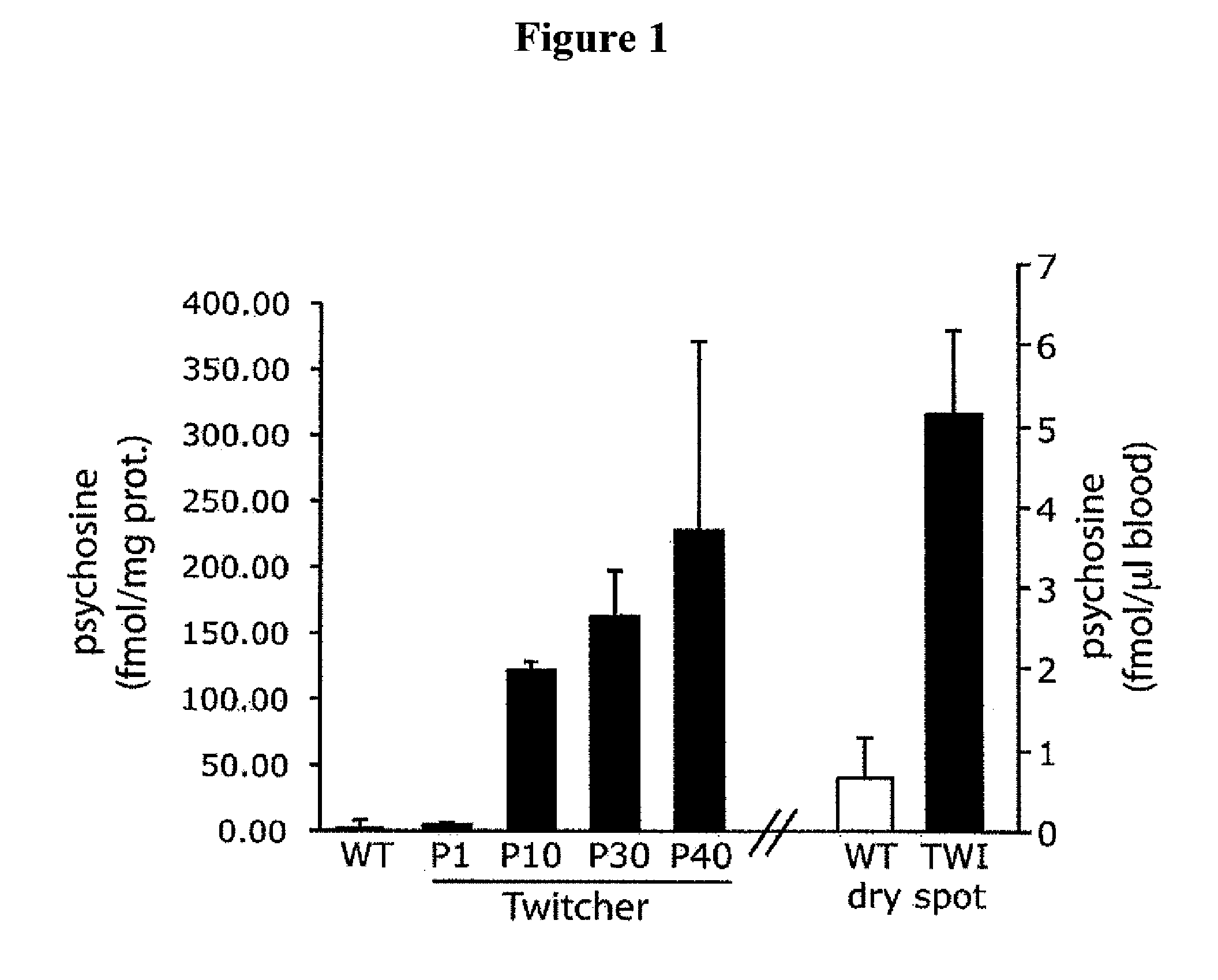Compositions and methods for the treatment of krabbe and other neurodegenerative diseases
- Summary
- Abstract
- Description
- Claims
- Application Information
AI Technical Summary
Benefits of technology
Problems solved by technology
Method used
Image
Examples
example 1
General Methods
[0151]Animals
[0152]Breeder Twitcher heterozygous mice (C57BL / 6J, twi / +, CD45.2 allele) and C57B16J mice carrying the CD45.1 allele were purchased from the Jackson Laboratory (Bar Harbor, Me.) and maintained under standard housing conditions. Analysis of the Twitcher mutation was performed as described in Dolcetta et al., J. Gene Med. 8:962-971 (2006). Twitcher mice were crossed with the Thyl.1:YFP line H+ / + Tg mice to produce TWI+ / − thyl.1:YFP+ / −. Mutant Twitchers expressing YFP (TWI-YFPax) were identified by PCR as described in Feng et al., Neuron 28:41-51 (2000) and Dolcetta et al., (2006). TWI and TWI-YFP genotypes were identified by PCR from tail DNA as described in Sakai et al., J. Neurochem. 66:1118-1124 (1996) and Feng et al., (2000).
[0153]Tissue Collection, Histology, and Immunohistochemistry
[0154]After performing all proper in vivo determinations, tissue was collected from mice deeply anesthetized and killed by perfusion with saline. Tissue dedicated for bioc...
example 3
Psychosine is Accumulated in Twitcher Neurons
[0193]The expression of GALC was examined in granule neurons (GN) of wild type mice. Granule neurons represent the most abundant neuron type in the CNS and their axons are generally not myelinated. Thus, axonal / neuronal defects are dissociated from demyelination.
[0194]GN were isolated from early postnatal cerebellum of wild type pups and cultured up to 8 days in vitro. GN were >95% enriched in neurons as determined by triple immunohistology for NeuN (neuron), GFAP (astrocytes), and 04 (oligodendrocytes). Immunoblotting using anti-GALC antibodies revealed a single band of −75 kDa in protein extracts from GN while extracts from brain showed a band of slightly higher size (FIG. 3A). Various sizes ranging from 50 to 80 kDa have been reported. Wenger et al., Mol. Genet. Metab. 70:1-9 (2000).
[0195]Twitcher GN accumulation of psychosine was measured using mass spectrometry analysis. During an 8-day incubation, mutant neurons significantly accumu...
example 4
Defective Axonal Transport in Twitcher Neurons
[0196]This Example demonstrates that neurons of GALC deficient Twitcher mutants develop defective axonal transport.
[0197]Because granules accumulate the potent toxin psychosine and because axonal transport is integral to neurons, Twitcher mice were evaluated for impaired axonal transport. Assuming that perturbed axonal transport would be reflected in an altered distribution of proteins associated with synaptic vesicles, the abundance of two such proteins, syntaxin and SNAP25, were measured in extracts isolated from the spinal cord and from distal sciatic nerves of Twitchers at P15 (a week before demyelination is detectable in the mutant). lmmunoblot analysis using specific antibodies revealed about 50% less SNAP25 in Twitcher sciatic nerves compared with WT nerves at P15 and almost complete absence of syntaxin in the mutant nerves (FIG. 4).
PUM
| Property | Measurement | Unit |
|---|---|---|
| Time | aaaaa | aaaaa |
| Time | aaaaa | aaaaa |
| Inhibition | aaaaa | aaaaa |
Abstract
Description
Claims
Application Information
 Login to View More
Login to View More - R&D
- Intellectual Property
- Life Sciences
- Materials
- Tech Scout
- Unparalleled Data Quality
- Higher Quality Content
- 60% Fewer Hallucinations
Browse by: Latest US Patents, China's latest patents, Technical Efficacy Thesaurus, Application Domain, Technology Topic, Popular Technical Reports.
© 2025 PatSnap. All rights reserved.Legal|Privacy policy|Modern Slavery Act Transparency Statement|Sitemap|About US| Contact US: help@patsnap.com



